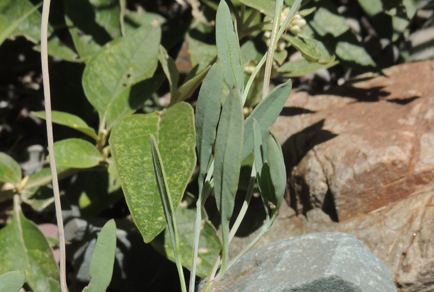Abstract
A new species of the genus Porophyllum (Asteraceae: Tageteae), P. iruyense, is described and illustrated. Photographs of the plant in its habitat and morphological details are given. This new species is endemic to the extreme north of Salta Province, where it grows in the rocky soil of the Sierra Santa Victoria. Porophyllum iruyense is characterized by being a decumbent odoriferous gynodioecious herb, with petiolate and lanceolate to narrowly ovate leaves with marginal pellucid cavities, and dark purple corollas. This species is known by locals for its medicinal properties. A table is given to differentiate it from other species inhabiting in South America, which are also gynodioecious and have the same dark purple colour in their corollas.
References
- Arduino, P. (1764) Animadversionum Botanicarum Specimen Alterum. Typographia Sansoniana, Veneza, 42 pp.
- Bachman, S., Moat, J., Hill, A.W., de la Torre, J. & Scott, B. (2011) Supporting Red List threat assessments with GeoCAT: geospatial conservation assessment tool. e-Infrastructures for data publishing in biodiversity science. ZooKeys 150: 117–126. [http://geocat.kew.org/] Version BETA https://doi.org/10.3897/zookeys.150.2109
- Beentje, H.J. (2010) The Kew Plant Glossary: An Illustrated Dictionary of Plant Identification Terms. Kew Publishing, Royal Botanic Gardens, Kew, 164 pp. https://doi.org/10.1111/j.1095-8339.2010.01099.x
- Cassini, H. (1819) Sixième mémoire sur la famille des Synanthérées, contenant les caractères des tribus. Journal de Physique, de Chimie, d´Histoire Naturelle et des Arts 88: 150–163.
- Guettard, J.E. (1754) Huitième mémoire sur les glandes des plants, & le septième sur l’usage que l’on peut faire de ces parties dans l’établissement des genres des plantes. Histoire de l’Académie Royale des Sciences 1750: 345–384.
- Hind, D.J.N. (2002) A new species of Porophyllum (Compositae: Heliantheae) from Bahia, Brazil. Kew Bulletin 57 (3): 705–709. https://doi.org/10.2307/4111003
- Hind, D.J.N. (2020) Porophyllum woodii (Compositae: Heliantheae: Pectidinae), a new species from Prov. Burnet O’Connor, Departamento de Tarija, Bolivia. Kew Bulletin 75: 61. https://doi.org/10.1007/s12225-020-09915-2
- Hooker, W.J. & Arnott, G.A.W. (1836) Contributions towards a flora of South America and the islands of the Pacific. I. Extra-Tropical South America. Companion to the Botanical Magazine 2: 41–52.
- IUCN Species Survival Commission (2012) IUCN Red List categories and criteria, version 3.1. Gland: IUCN. [https://portals.iucn.org/library/sites/library/fles/documents/RL-2001-001.pdf]
- IUCN Standards and Petitions Committee (2019) Guidelines for Using the IUCN Red List Categories and Criteria, version 14. Prepared by the Standards and Petitions Committee. [http://www.iucnredlist.org/documents/RedListGuidelines.pdf]
- Johnson, R.R. (1969) Monograph of the Plant Genus Porophyllum (Compositae—Helenieae). The University of Kansas Science Bulletin 48 (7): 225–267.
- Malme, G.O. (1899) Die Compositen der Ersten Regnell’schen Expedition. Kongliga Svenska Vetenskaps-akademiens Handlingar 32 (5): 1–90 & Taf. I–VII.
- Morello, J., Matteucci, S.D., Rodriguez, A.F. & Silva, M.E. (2012) Ecorregiones y complejos ecosistémicos argentinos. Orientación Gráfica Editora, Buenos Aires, 752 pp.
- Nic Lughadha, E., Bachman, S.P., Leão, T.C.C., Forest, F., Halley, J.M., Moat, J., Acedo, C., Bacon, K.L., Brewer, R.F.A., Gâteblé, G., Gonçalves, S.C., Govaerts, R., Hollingsworth, P.M., Krisai-Greilhuber, I., de Lirio, E.J., Moore, P.G.P., Negrão, R., Onana, J.M., Rajaovelona, L.R., Razanajatovo, H., Reich, P.B., Richards, S.L., Rivers, M.C., Cooper, A., Iganci, J., Lewis, G.P., Smidt, E.C., Antonelli, A., Mueller G.M. & Walker, B.E. (2020) Extinction risk and threats to plants and fungi. Plants, People, Planet 2: 389–408. https://doi.org/10.1002/ppp3.10146
- Petenatti, E.M. (2015) Porophyllum Guett. In: Anton, A.M. & Zuloaga, F.O. (Eds.) Flora Vascular de la República Argentina, vol. 7 (2). Estudio Sigma SRL, Buenos Aires, pp. 109–114.
- Quantum GIS Development Team (2022) QGIS Geographic Information System. Open Source Geospatial Foundation. [http://qgis.org]
- Thiers, B. (2023 [continuously updated]) Index Herbariorum: A global directory of public herbaria and associated staff. New York Botanical Garden’s Virtual Herbarium. Available from: http://sweetgum.nybg.org/ih/ (accessed 24 April 2023)


